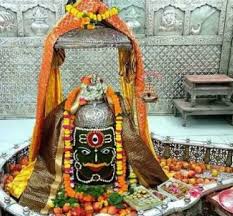Table of Contents
ToggleMahakaleshwar Jyotirlinga

Mahakaleshwar Jyotirlinga
Mahakaleshwar is one of the twelve Jyotirlingas dedicated to Lord Shiva and is located in the city of Ujjain, Madhya Pradesh, India. This temple is one of the most significant and revered religious sites for Hindus.
Key Information about Mahakaleshwar Jyotirlinga:
1. Significance of Mahakaleshwar:
- Mahakaleshwar is considered to be one of the most powerful Jyotirlingas in India, representing Lord Shiva’s supreme form.
- It is believed that worshipping Mahakaleshwar will help one overcome all obstacles, sins, and grant blessings for peace and prosperity.
- The name “Mahakal” means “the Lord of Time” or “the Great Time,” signifying Shiva as the ultimate force who controls time, life, and death.
2. Location:

Mahakaleshwar Jyotirlinga
- City: Ujjain, Madhya Pradesh, India.
- Historical Significance: Ujjain is one of the ancient cities in India and holds great religious importance as it is one of the seven Moksha Puris (cities that offer liberation).
- The temple is situated near the banks of the Kshipra River.
3. Temple Architecture:
- The Mahakaleshwar temple showcases an impressive blend of Maratha, Vesara, and Nagara architectural styles.
- The sanctum sanctorum (garbhagriha) of Mahakaleshwar is unique because it houses a swayambhu lingam (self-manifested lingam), unlike many other Jyotirlingas where the lingam is installed.
- The temple has a grand Shiva idol, and the inner chamber has an impressive Shiva Lingam, which is believed to be a symbol of the infinite power of Lord Shiva.
- There are various other shrines dedicated to Lord Shiva, Goddess Parvati, Lord Ganesha, and Lord Kartikeya in the temple complex.
4. Puja and Rituals:
- The daily rituals of the temple involve the Bhasma Aarti, a unique form of worship where ash is used to offer prayers to Lord Shiva. This aarti is performed early in the morning and is a major highlight of the temple.
- The temple also conducts the Shivaratri festival with great zeal and attracts millions of devotees every year.
- Devotees offer milk, honey, ghee, and flowers to the idol during their visits.
5. Mahakaleshwar in Hindu Mythology:
- According to ancient scriptures, the Mahakaleshwar Jyotirlinga was revealed to King Chandrasena, who was a devotee of Lord Shiva. The temple is believed to have been built on the site of the ancient shrine where Shiva manifested himself.
- Mahakaleshwar is believed to have been a powerful protector and was instrumental in protecting the city of Ujjain from invaders.
- Legends suggest that the temple’s deity is so powerful that even when enemies attacked Ujjain, the deity of Mahakaleshwar is said to have protected the city from destruction.
6. Mahakaleshwar’s Unique Feature:
- Bhasma Aarti: One of the major rituals performed at Mahakaleshwar is the Bhasma Aarti, performed at dawn. This ritual involves offering bhasma (ash) to the Shiva Lingam. It is considered to purify the devotee’s soul and is a highly revered ritual in Ujjain.
- The temple is one of the few Jyotirlingas where the Shiva Lingam is believed to be self-originated or swayambhu, and it is the only Jyotirlinga in India where the deity faces south, which is considered very powerful in Hindu rituals.
7. Festivals and Events:
- The most important festival celebrated at the Mahakaleshwar Temple is Shivaratri, which sees a huge influx of devotees from all over the world.
- Nag Panchami, Karva Chauth, and Maha Shivaratri are other prominent festivals where special prayers, rituals, and celebrations take place.
8. Accessibility:
- Air: The nearest airport is in Indore, approximately 55 km from Ujjain.
- Rail: Ujjain is well-connected by rail to major cities across India.
- Road: Ujjain is connected by road to cities like Indore, Bhopal, and others.
9. Interesting Fact:
- Mahakaleshwar Temple is unique because it is one of the few temples where a Jyotirlinga is worshipped as a Ujjain-based deity, making it a very important pilgrimage spot for Hindus.
- The temple is also known for its Mahakaleshwar Utsav (annual festival) and Shivaratri celebrations that attract thousands of pilgrims.
Mahakaleshwar Jyotirlinga is not just a religious place but a symbol of divine power. Devotees believe that it helps in purifying the soul and brings them closer to salvation. The temple’s historical, spiritual, and architectural significance makes it a must-visit for anyone seeking spiritual enlightenment or understanding India’s deep-rooted cultural heritage.
The history of the Mahakaleshwar Jyotirlinga is steeped in rich mythology and ancient religious traditions. This temple is one of the most important shrines for Hindus and is considered to be one of the 12 Jyotirlingas, which are sacred abodes of Lord Shiva. Below is a detailed exploration of the history and mythology associated with the Mahakaleshwar Jyotirlinga.
Historical and Mythological Background of Mahakaleshwar:
1. Origin of the Mahakaleshwar Jyotirlinga:
- Swayambhu (Self-manifested): The Mahakaleshwar Jyotirlinga is believed to be Swayambhu, meaning it self-manifested. According to Hindu scriptures, it is said that Lord Shiva manifested himself in the form of a Shiva Lingam in Ujjain to protect the region from any threats and to bless the devotees.
- Legend of King Chandrasena: One popular legend associated with the origin of Mahakaleshwar comes from the time of King Chandrasena, who ruled over the region of Ujjain. The king was a devoted worshiper of Lord Shiva and had deep faith in the deity. According to the story, a demon named Dushan attacked the kingdom of Ujjain. The king, with the help of Lord Shiva, defeated the demon and saved his people. Impressed by the king’s devotion and valor, Lord Shiva manifested in the form of the Mahakaleshwar Jyotirlinga to protect the region and its inhabitants.
Another version of the story says that the demon Dushan and his forces were terrorizing the world, and the gods sought Lord Shiva’s help. Lord Shiva, in his mighty form as Mahakal (the Lord of Time), destroyed the demon and his army, thus restoring peace to the world.
2. Connection to Ujjain:
- Ujjain as a Sacred City: Ujjain, also known as Ujjayini, is one of the ancient cities in India and holds a significant place in Hindu history. It is one of the seven Moksha Puris, or cities that are believed to help people attain liberation (moksha) when visited by devotees. Ujjain is also known for being the site of many significant events in Hindu mythology.
- The temple of Mahakaleshwar is located on the banks of the Kshipra River, and it has been a sacred site since ancient times, with many Hindu texts referring to its importance.
3. Mahakaleshwar in Hindu Scriptures:
- Mahakaleshwar is mentioned in various Puranas and scriptures, including the Skanda Purana and Shiva Purana. These texts describe the worship of Lord Shiva as being highly significant for spiritual progress, and the Mahakaleshwar temple is depicted as a powerful center of worship.
- The Shiva Purana specifically mentions that the Mahakaleshwar Jyotirlinga was established to protect the land and its people. In fact, the name “Mahakal” emphasizes Lord Shiva as the “Lord of Time,” who is eternal and governs all of creation, birth, and destruction.
4. The Legend of Ravana’s Worship:
- Another famous legend associated with the Mahakaleshwar temple is the story of Ravana, the demon king of Lanka. According to the story, Ravana was a devout worshipper of Lord Shiva and once sought to bring the Shiva Lingam to Lanka for worship.
- He performed intense penance to Lord Shiva, and in return, Shiva granted him the Mahakala Lingam. However, the gods were concerned that Ravana’s power would become too immense, so they intervened.
- In some versions of the legend, it is said that as Ravana was carrying the lingam, he had to stop at Ujjain. He handed over the lingam to a Brahmin who tricked him into placing it on the ground, thus causing the lingam to become permanently established at Ujjain as the Mahakaleshwar Jyotirlinga.
5. The Miracle of the Mahakaleshwar Lingam:
- The Mahakaleshwar Lingam is unique in that it is one of the few Jyotirlingas in India that is believed to be self-manifested (Swayambhu). It is said that Lord Shiva, in his infinite power, manifested himself in the form of this lingam and that the lingam radiates a divine light, signifying Shiva’s eternal and formless nature.
- The lingam is also said to face south, which is considered very auspicious in Hindu mythology. South-facing Shiva Lingams are considered to be the most powerful because they symbolize the destroyer aspect of Lord Shiva’s personality, who brings an end to time and all creations.
6. Mahakaleshwar and the Time (Kala):
- The name Mahakal refers to Lord Shiva’s role as the “Lord of Time.” In Hindu philosophy, time is often seen as a destructive force, and Mahakal is regarded as the force that governs it.
- Lord Shiva is known as Mahakal, because it is believed that he transcends time and is beyond the limitations of the material world. In this sense, Mahakaleshwar is revered as the deity who represents the eternal truth and the ultimate power that governs life, death, and everything in between.
7. Historical Accounts:
- Historically, the Mahakaleshwar temple has undergone various renovations and reconstructions, particularly during the reigns of Mauryas, Guptas, and Solankis. The temple complex has been a place of pilgrimage for centuries, and it has attracted millions of devotees over time.
- During the Maratha rule in the 18th century, Rani Ahilya Bai Holkar of Indore renovated the temple and ensured its maintenance. Under her leadership, the temple gained even more prominence, and her contributions to its preservation are still remembered today.
8. Modern-Day Significance:
- Today, the Mahakaleshwar Jyotirlinga continues to be one of the most important pilgrimage destinations in India. The temple attracts millions of devotees every year, especially during Shivaratri, when grand celebrations are held.
- The Bhasma Aarti, performed early in the morning, remains one of the most unique and revered rituals in the temple. Devotees believe that offering prayers to Mahakaleshwar brings spiritual blessings, protection from negative forces, and liberation from the cycle of life and death.
Certainly! Here’s a more detailed look at Mahakaleshwar Jyotirlinga, including its significance, rituals, architecture, and unique aspects that make it one of the most revered sites for Hindus.
More Detailed Information about Mahakaleshwar Jyotirlinga:
1. Significance of Mahakaleshwar:
-
Mahakal (Lord of Time): The term “Mahakal” refers to Lord Shiva as the Lord of Time. Shiva is considered the controller of time, creation, preservation, and destruction in Hinduism. By his nature, he is eternal and beyond the realms of time, hence the name “Mahakal” signifies that he governs over the inevitable forces of time and death.
-
One of the 12 Jyotirlingas: Mahakaleshwar is one of the 12 Jyotirlingas—sacred shrines dedicated to Lord Shiva. The Jyotirlingas represent the infinite form of Lord Shiva, who transcends all limits. Each of these 12 Jyotirlingas holds unique power, and Mahakaleshwar is especially significant due to its unique features.
-
Spiritual Importance: Devotees believe that worshipping the Mahakaleshwar Jyotirlinga grants them spiritual benefits, including moksha (liberation from the cycle of birth and death). The temple is considered a Moksha Puri (a city where salvation can be attained).
2. Location and Geography:
- City: The Mahakaleshwar Temple is located in Ujjain, Madhya Pradesh, one of the seven Moksha Puris or sacred cities that are believed to help attain liberation (moksha). Ujjain has been a center of spiritual activity for thousands of years and is an ancient city mentioned in Hindu scriptures like the Mahabharata and Ramayana.
- Kshipra River: The temple is located near the banks of the Kshipra River, which is considered one of the holiest rivers in India. It is believed that a holy dip in the Kshipra River purifies the body and soul before visiting the temple.
3. Unique Features of the Mahakaleshwar Temple:
- Swayambhu (Self-manifested) Lingam: The Mahakaleshwar Jyotirlinga is Swayambhu, meaning it is self-manifested and does not have any human intervention in its installation. The Shiva Lingam in the temple is said to have appeared naturally, which makes it highly revered among all the Jyotirlingas.
- South-facing Lingam: One of the unique features of the Mahakaleshwar temple is that the Shiva Lingam faces south, which is considered highly auspicious in Hinduism. South-facing deities are associated with the destruction aspect of Lord Shiva. This is very significant as Lord Shiva is believed to be the ultimate destroyer of time and space.
- Bhasma Aarti: One of the temple’s most unique rituals is the Bhasma Aarti, which is performed early in the morning. The bhasma (ash) is used in the worship and is considered sacred. The ash is collected from the pyres of the dead, symbolizing the transience of life, and is offered to the deity. The Bhasma Aarti is one of the most important and powerful rituals at the Mahakaleshwar temple.
4. Temple Architecture:
- Design and Structure: The Mahakaleshwar temple showcases Maratha, Vesara, and Nagara architectural styles. The temple’s grand structure includes a Shikhara (spire) and pillars that have been intricately carved with motifs of gods, goddesses, and celestial beings.
- Main Shrine (Sanctum Sanctorum): The temple’s central shrine houses the Mahakaleshwar Lingam. The temple’s design reflects the grandeur and spiritual energy that surround the deity of Mahakal.
- Garbha Griha (Inner Sanctum): The inner sanctum, or Garbha Griha, houses the Shiva Lingam, which is the focal point of worship. This Lingam is believed to have been established by Lord Shiva himself.
5. Important Rituals and Festivals:
- Bhasma Aarti: This is a significant and unique ritual performed at dawn. The ashes from the funeral pyres are applied to the Shiva Lingam in an ancient custom. The Bhasma Aarti, which is performed early in the morning, is one of the most profound rituals at Mahakaleshwar and attracts large crowds of devotees.
- Shivaratri Festival: The temple is one of the key pilgrimage sites during Maha Shivaratri, which is a festival dedicated to Lord Shiva. The temple sees large gatherings of devotees, and the night-long prayers and rituals are an integral part of the celebrations. This is a time when the temple is elaborately decorated, and various rituals like Rudra Abhishekam and Mahakaleshwar Aarti are conducted.
- Navratri: Although Navratri is predominantly a festival of Goddess Durga, the Maha Ashtami and Maha Navami days are also significant for the worship of Lord Shiva at Mahakaleshwar. Devotees fast and perform various rituals during this time.
6. Legends and Mythology:
- The Mahakaleshwar Legend: According to one legend, the demon Dushan and his brother Dushana created havoc in the world, including Ujjain. The gods, led by Lord Vishnu and Lord Brahma, turned to Lord Shiva for help. Shiva manifested as Mahakal, and his powerful form destroyed the demon and his army. It is from this act that the Mahakaleshwar Jyotirlinga was established in Ujjain to protect the land and its people.
- Ravana and the Mahakaleshwar Lingam: Another popular legend is related to Ravana, the demon king of Lanka. Ravana, a great devotee of Lord Shiva, once performed intense penance to seek the blessings of Lord Shiva. Shiva appeared before him and gave him the Mahakaleshwar Lingam. However, Ravana was tricked by the gods and was forced to place the lingam in Ujjain. Thus, Mahakaleshwar became a permanent fixture in Ujjain, and Ravana’s devotion to Lord Shiva remains legendary.
- Lord Shiva as Mahakal: As Mahakal, Lord Shiva represents the ultimate force that governs time and the universe. His aspect as Mahakal signifies his ability to destroy not only physical entities but also time itself, which is an inevitable force in life. This attribute makes Mahakaleshwar one of the most powerful temples in Hinduism.
7. How to Reach Mahakaleshwar Temple:
- By Air: The nearest airport is in Indore, approximately 55 km away. Indore has regular domestic flights connecting it to major cities across India.
- By Train: Ujjain is well-connected by rail to several cities. The Ujjain Railway Station is approximately 3-4 kilometers from the temple.
- By Road: Ujjain is connected by road to nearby cities like Indore, Bhopal, and others. Various state transport buses and private vehicles are available for easy access.
8. Mahakaleshwar and the Modern-Day:
- Tourism and Pilgrimage: Mahakaleshwar is not only a religious center but also a major tourist destination. The temple attracts millions of devotees annually, especially during festivals like Maha Shivaratri and Navratri.
- Development and Facilities: The Mahakaleshwar Temple has seen extensive renovations and developments, especially under the leadership of the Madhya Pradesh Government and the Ujjain Municipal Corporation. The temple complex now features enhanced facilities for devotees, including better roads, accommodations, and improved infrastructure.
- Global Recognition: Over time, Mahakaleshwar has become an international pilgrimage site, with devotees from across the globe visiting the temple to seek the blessings of Lord Shiva.
Conclusion:
Mahakaleshwar Jyotirlinga is not only a symbol of divine energy but also a center of spiritual transformation. It is believed that visiting the Mahakaleshwar temple and offering prayers can cleanse one’s soul and help them on the path to moksha. With its rich mythology, powerful presence, and unique rituals, Mahakaleshwar stands as one of the most important religious and historical landmarks in India.The history of Mahakaleshwar Jyotirlinga is deeply intertwined with religious texts, mythological stories, and historical events. It is a symbol of Lord Shiva’s eternal power and protection, and its significance transcends time. The temple’s rich history, along with its spiritual and cultural importance, makes it one of the most visited and revered shrines in Hinduism.

Mahakaleshwar Jyotirlinga






Recent Comments